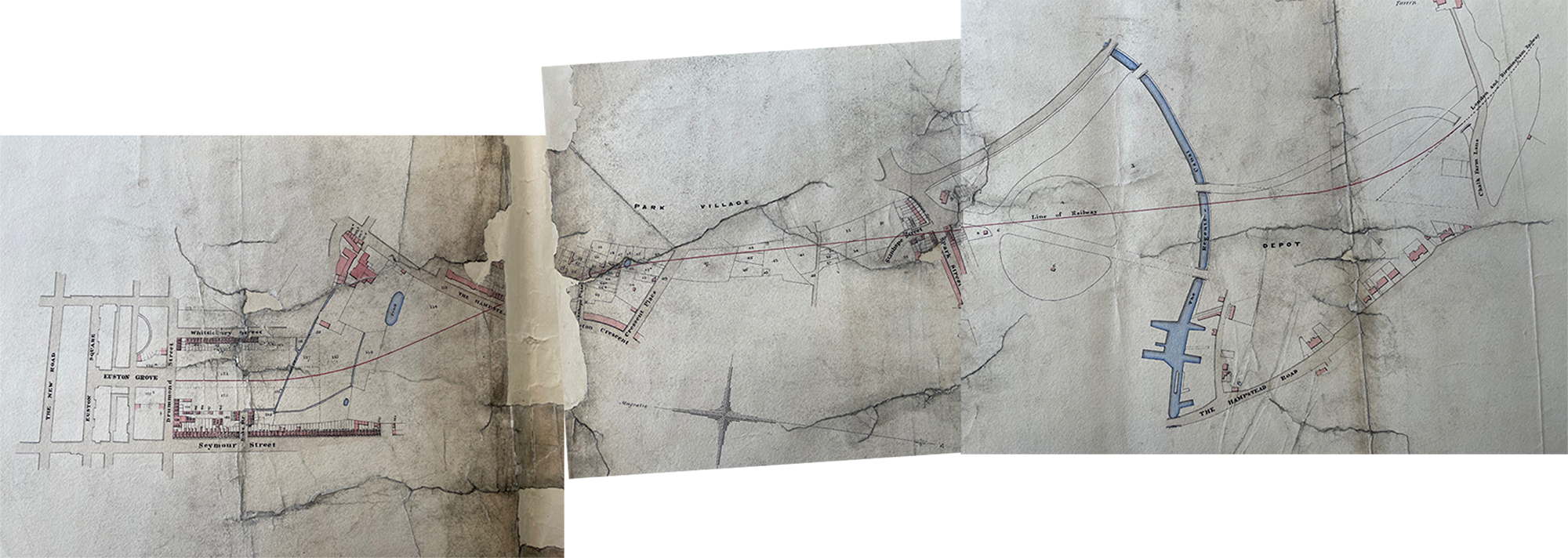
Railway ︎︎︎
The whole area has a dense network of railway tracks. These include mainline railways running into the terminuses of Euston, St Pancras, and Marylebone that criss-cross, cut under, through or near Chalcots, Alexandra Road and Hilgrove Estates as well as London Underground overground, commuter and freight services. Their development tracks the movement from private to public interests and back again. Their density, rise, fall and maintenance follows the stock market bubble caused by Railway Mania in the Victorian era to nationalisation under British Rail from 1965-1997 and municipalisation under Transport for London (TfL). The density of key railway infrastructure in the area meant that it became a target for bombing during the Second World War. The lines as they operate today are listed below:
TfL services
London Overground: Euston to Watford Junction
London Underground: Metropolitan Line (Baker Street to Chesham, Watford and Amersham), Jubilee Line (Stratford to Stanmore)
Mainline Railways
Midland Mainline: London St Pancras to Sheffield, East Midlands Railway
West Coast Mainline: London Euston to Glasgow via Birmingham, Avanti West Coast and London Euston to Liverpool via Birmingham, London Northwestern Railway (slow line)
Chiltern Mainline: London Marylebone to Birmingham
Commuter services
Thameslink: Brighton to St. Albans
Under construction
HS2: London Euston to Birmingham
Nearby disused stations
Primrose Hill Station closed in 1992. The former station building over the Regent’s Park Road footbridge which crosses the West Coast and Chiltern mainlines is now a hot yoga studio. Lord’s Station and Marlborough Road Station were both closed in 1939. They were initially intended to serve commuters into the city from St John’s Wood and were built by the Metropolitan and St John’s Wood Railway in 1868. As what became known as Metro-land expanded and new suburban homes were built by the Metropolitan Railway, when these stations became too congested to operate,the Metropolitan Railway opted to prioritise the highly profitable suburban areas it was building to the northwest of London.
It is said that when the disused Marlborough Road station became a Chinese Restaurant, the chopsticks on the tables would rattle and move every time a train rumbled past beneath the diners.
There are also disused ‘ghost’ platforms at Swiss Cottage and Finchley Road. The former were used as bomb shelters during the Second World War.
Tunnels
In addition to the tube, the area has five main railway tunnels, the Primrose Hill tunnel, the Hampstead tunnel, the South Hampstead tunnel and the Belsize tunnel slightly to the north of the study area. In addition to these tunnels are the current tunnelling operations for HS2.
The Primrose Hill tunnel runs very close to Chalcots and under Hilgrove. The tunnel was the first railway tunnel in London and one of the earliest built in Britain. The Primrose Hill tunnel begins at Primrose Hill Road to the east, runs under the villas developed by Eton College and emerges at the junction of Hilgrove and Alexandra Roads. The tunnel was built because Eton College demanded no loss of buildable land. The tunnel mouth also had to be built to the satisfaction of the provost and college. The consequent ornamental construction of the tunnel mouth led to it becoming a visitor attraction.
Each end of the tunnel (19m on either side) was built using the ‘cut and cover’ technique which was later used on the London Underground. Cut and cover involves the excavation of shallow trenches which are then roofed over with an overhead support system. The main tunnel was excavated from four 2.4m shafts advancing no more than 2m ahead of the brickwork lining. One of the shafts is still used for ventilation and can be found in the car park of the Marriott Hotel, just west of Hawtrey Road and near the midpoint of the tunnel.
As part of the development of HS2, a new tunnel is being built that will run from Euston Station to Old Oak Common Station. The tunnel will run under or near Hilgrove, Chalcots and Alexandra Road Estates as well as a number of other social housing estates in Camden. The tunnel will be bored under several other social housing estates. The tunnel will be 7.2km long and will run 50 m below ground. Work will begin in 2024. The tunnel will be bored using Twin Boring Machines which operate as a self-contained factory and will run 24/7, deep beneath the ground. HS2 will assess, monitor, and support settlement and subsidence. HS2 will work to manage disruption to local residents caused by noise, vibration, congestion on the roads, impacts on waterworks, dust and debris.





